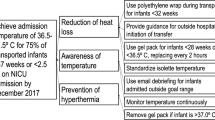Abstract
Objective:
To compare the pattern of thermal stabilization seen in infants born at a rural primary health center (PHC) with that of infants born in an modern urban tertiary care hospital (TCH).
Study Design:
Abdominal temperature (Ta) and foot temperature (Tf) of healthy term newborn infants were monitored and electronically recorded continuously from birth in the delivery room (DR) until 12 h of life in the postnatal ward (PNW) at two sites. A total of 71 infants were enrolled in the study: 51 infants at the PHC and 20 infants at the TCH.
Result:
In infants delivered at TCH the maximum mean (±s.d.) Ta of 36.4 °C±0.48 was reached by 12 h, while at PHC maximum mean Ta was 35.4 °C (1.98) by 10.5 h. The mean Tf improved from the lowest value of 29.7 °C±1.3 at 4.5 h to 32.9 °C±1.6 by 12 h of life in infants delivered at TCH, whereas in infants delivered at PHC Tf remained low (maximum 30.7 °C) all through 12 h. The mean Td (Ta–Tf) gradually decreased from a maximum of 5.9 °C±1.6 at 4.5 h to 3.5 °C±1.5 by 12 h of life in infants born at TCH, but the Td remained at >5 °C even after 6 h of life in infants born at PHC, which was statistically significant (P<0.05). The calculated area between the Ta and Tf, a proxy for metabolic stress was greater in babies born at PHC than those born at TCH.
Conclusion:
Our study shows that although both groups of newborn infants experienced significant thermal stress, infants delivered at PHC experienced significantly greater thermal stress than babies born at TCH. This difference could be attributed to the differences in thermal environment of DR and PNW between PHC and TCH.
This is a preview of subscription content, access via your institution
Access options
Subscribe to this journal
Receive 12 print issues and online access
$259.00 per year
only $21.58 per issue
Buy this article
- Purchase on Springer Link
- Instant access to full article PDF
Prices may be subject to local taxes which are calculated during checkout

Similar content being viewed by others
References
Power GG, Blood AB, Hunter CJ . Perinatal thermal physiology. In: Polin RA, Fox WW, Abman SH (eds). Fetal and Neonatal Physiology, 3rd edn. Saunders Elsevier: Philadelphia, PA, 2004, pp 541–548.
Silverman W, Sinclair J . Temperature regulation in the newborn infant. N Engl J Med 1966; 274: 92–94.
Hill J, Rahimtulla K . Heat balance and the metabolic rate of newborn babies in relation to environmental temperature; and the effect of age and of weight on basal metabolic rate. J Physiol 1965; 180: 239–265.
Asakura H . Fetal and neonatal thermoregulation. J Nippon Med Sch 2004; 71 (6): 360–370.
Soll R . Heat loss prevention in neonates. J Perinatol 2008; 28: S57–S59.
Fransson A-L, Karlsson H, Nilsson K . Temperature variation in newborn babies: importance of physical contact with mother. Arch Dis Child Fetal Neonatal Ed 2005; 90: F500–F504.
Ellis M, Manandhar N, Shakya U, Manandhar DS, Fawdry A, Costello AM . Postnatal hypothermia and cold stress among newborn infants in Nepal monitored by continuous ambulatory monitoring. Arch Dis Child 1996; 75: F42–F45.
Kamabrami RO, Pereira N . Thermo spot in detection of neonatal hypothermia. Ann Trop Pediatr 2002; 22: 219–223.
Osrin D, Manandhar MK . Cross sectional, community based study of care of newborn infants in Nepal. BMJ 2002; 325: 1063.
Miharu N, Hidekotu S, Rie N . Change in newborn body temperature of newborn babies during 12 h and effects of environmental factors. Bull Yamanashi Med Univ 1998; 15: 28–34.
Smales OR, Kime R . Thermoregulation in babies immediately after birth. Arch Dis Child 1978; 53 (1): 58–61.
Singh M, Rao G, Malhotra AK, Deorari AK . Assessment of newborn baby's temperature by human touch: a potentially useful primary care strategy. Indian Pediatr 1992; 29 (4): 449–452.
American Heart Association (AHA) Guidelines for Cardiopulmonary Resuscitation (CPR) and Emergency Cardiovascular Care (ECC) of Pediatric and Neonatal Patients: Neonatal Resuscitation Guidelines. Pediatrics 2006; 117 (5): e1029–e1038.
David B Copyright © 2002-10. AUC calculation using trapezoidal rule.
Mullany L, Katz J, Khatry S, LeClerq S, Darmstadt GL, Tielsch J . Neonatal hypothermia and associated risk factors among newborns of Southern Nepal. BMC Med 2010; 8: 43.
Bang AT, Reddy HM, Deshmukh MD, Baitule SB, Bang RA, Kumar R et al. Neonatal and infant mortality in the ten years (1993 to 2003) of the Gadchiroli field trial: effect of home-based neonatal care. J Perinatol 2005; 25 (Suppl 1): S92–S107.
Kumar R, Aggarwal AK . Body temperatures of home delivered newborns in north india. Trop Doct 1998; 28 (3): 134–137.
Byaruhanga R, Bergstrom A, Okong P . Neonatal hypothermia in Uganda: prevalence and risk factors. J Trop Pediatr 2005; 51 (4): 212–215.
Christenson K, Bhat GJ, Eriksson B, Shilalukey-Ngoma M, Sterky G . The effect of routine hospital care on the health of hypothermic newborn infants in Zambia. J Trop Pediatric 1995; 41 (4): 210–214.
Kumar V, Mohanty S, Kumar A, Misra R, Santosham M, Awasthi S et al. Effect of community-based behavior change management on neonatal mortality in Shivgarh, Uttar Pradesh, India: a cluster-randomized controlled trial. Lancet 2010; 372 (9644): 1151–1162.
Malin S, Baumgart S . Optimal thermal management for low birth weight infants nursed under high powered radiant warmers. Pediatrics 1987; 79: 47–54.
World Health Organization 1997, Maternal and Newborn Health. Thermal Protection of the Newborn: A Practical Guide. World Health Organization: Geneva, Switzerland. WHO reference number: WS 420 97TH (English).
http://www.mohfw.nic.in/NRHM.htm, Ministry of Health & Family Welfare, Government of India (accessed on 10 November 2010).
Indian Public Health Standards (IPHS) For Primary Health Centers. Guidelines (March 2006). Directorate General Of Health Services, Ministry of Health & Family Welfare, Government Of India.
Knippenberg R, Lawn J, Darmstadt G, Begkoyian G, Fogstad H, Walelign N et al. Systematic scaling up of neonatal care in countries. Lancet 2005; 365: 1087–1098.
Bhutta Z, Chopra M, AxelsonH, Berman P, Boerma T, Bryce J et al. Countdown to 2015 decade report (2000-10): taking stock of maternal, newborn, and child survival. Lancet 2005; 375: 2032–2044.
Winch P, AlamM, AktherA, Afroz D, Ali NA, Ellis AA et al. Local understanding of vulnerability and protection during neonatal period in Sylhet District, Bangladesh: a qualitative study. Lancet 2005; 366: 478–485.
Choudhry UK . Traditional practices of women from India: pregnancy, childbirth, and newborn care. J Obstet Gynecol Neonatal Nurs 1997; 26 (5): 533–539.
Kumar V, Shearer J, Kumar A, Darmastadt GL . Neonatal hypothermia in low resource setting. J Perinatol 2009; 29 (6): 401–412.
Acknowledgements
We are immensely thankful to the staff nurses of the Delivery room and Postnatal Ward of KLES Dr. Prabhakar Kore Charitable Hospital & MRC, Belgaum for their immense support in conducting this study. Dr Santosh Tamgond, Registrar, Department of Pediatrics helped in initiating the monitoring in Dr. We would thank Dr Saudagar and the rest of the staff of Kinaye PHC for their support and interest during the training and later for the conduction of this study. We would also like to thank Mr Mallapure, Lecturer, JN Medical College, Belgaum and Mr S Bhide for statistical analysis and Mr Tejas Bengali, Assistant Manager—Design and Development, L&T Company, Mysore, India for providing technical guidance.
Author information
Authors and Affiliations
Corresponding author
Ethics declarations
Competing interests
The authors declare no conflict of interest.
Rights and permissions
About this article
Cite this article
Bhandankar, M., Patil, V. & Vidyasagar, D. Differences in thermal adaptation of infants delivered at primary or tertiary care facilities in India. J Perinatol 32, 502–507 (2012). https://doi.org/10.1038/jp.2011.134
Received:
Revised:
Accepted:
Published:
Issue Date:
DOI: https://doi.org/10.1038/jp.2011.134
Keywords
This article is cited by
-
Oxygen Saturation Immediately after Birth in Infants Delivered in Tertiary Care Hospital in India
The Indian Journal of Pediatrics (2014)



